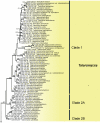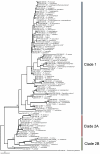Phylogeny and nomenclature of the genus Talaromyces and taxa accommodated in Penicillium subgenus Biverticillium
- PMID: 22308048
- PMCID: PMC3233910
- DOI: 10.3114/sim.2011.70.04
Phylogeny and nomenclature of the genus Talaromyces and taxa accommodated in Penicillium subgenus Biverticillium
Abstract
The taxonomic history of anamorphic species attributed to Penicillium subgenus Biverticillium is reviewed, along with evidence supporting their relationship with teleomorphic species classified in Talaromyces. To supplement previous conclusions based on ITS, SSU and/or LSU sequencing that Talaromyces and subgenus Biverticillium comprise a monophyletic group that is distinct from Penicillium at the generic level, the phylogenetic relationships of these two groups with other genera of Trichocomaceae was further studied by sequencing a part of the RPB1 (RNA polymerase II largest subunit) gene. Talaromyces species and most species of Penicillium subgenus Biverticilliumsensu Pitt reside in a monophyletic clade distant from species of other subgenera of Penicillium. For detailed phylogenetic analysis of species relationships, the ITS region (incl. 5.8S nrDNA) was sequenced for the available type strains and/or representative isolates of Talaromyces and related biverticillate anamorphic species. Extrolite profiles were compiled for all type strains and many supplementary cultures. All evidence supports our conclusions that Penicillium subgenus Biverticillium is distinct from other subgenera in Penicillium and should be taxonomically unified with the Talaromyces species that reside in the same clade. Following the concepts of nomenclatural priority and single name nomenclature, we transfer all accepted species of Penicillium subgenus Biverticillium to Talaromyces. A holomorphic generic diagnosis for the expanded concept of Talaromyces, including teleomorph and anamorph characters, is provided. A list of accepted Talaromyces names and newly combined Penicillium names is given. Species of biotechnological and medical importance, such as P. funiculosum and P. marneffei, are now combined in Talaromyces. Excluded species and taxa that need further taxonomic study are discussed. An appendix lists other generic names, usually considered synonyms of Penicillium sensu lato that were considered prior to our adoption of the name Talaromyces.
Taxonomic novelties: Taxonomic novelties:New species - Talaromyces apiculatus Samson, Yilmaz & Frisvad, sp. nov. New combinationsand names - Talaromyces aculeatus (Raper & Fennell) Samson, Yilmaz, Frisvad & Seifert, T. albobiverticillius (H.-M. Hsieh, Y.-M. Ju & S.-Y. Hsieh) Samson, Yilmaz, Frisvad & Seifert, T. allahabadensis (B.S. Mehrotra & D. Kumar) Samson, Yilmaz & Frisvad, T. aurantiacus (J.H. Mill., Giddens & A.A. Foster) Samson, Yilmaz, & Frisvad, T. boninensis (Yaguchi & Udagawa) Samson, Yilmaz, & Frisvad, T. brunneus (Udagawa) Samson, Yilmaz & Frisvad, T. calidicanius (J.L. Chen) Samson, Yilmaz & Frisvad, T. cecidicola (Seifert, Hoekstra & Frisvad) Samson, Yilmaz, Frisvad & Seifert, T. coalescens (Quintan.) Samson, Yilmaz & Frisvad, T. dendriticus (Pitt) Samson, Yilmaz, Frisvad & Seifert, T. diversus (Raper & Fennell) Samson, Yilmaz & Frisvad, T. duclauxii (Delacr.) Samson, Yilmaz, Frisvad & Seifert, T. echinosporus (Nehira) Samson, Yilmaz & Frisvad, comb. nov. T. erythromellis (A.D. Hocking) Samson, Yilmaz, Frisvad & Seifert, T. funiculosus (Thom) Samson, Yilmaz, Frisvad & Seifert, T. islandicus (Sopp) Samson, Yilmaz, Frisvad & Seifert, T. loliensis (Pitt) Samson, Yilmaz & Frisvad, T. marneffei (Segretain, Capponi & Sureau) Samson, Yilmaz, Frisvad & Seifert, T. minioluteus (Dierckx) Samson, Yilmaz, Frisvad & Seifert, T. palmae (Samson, Stolk & Frisvad) Samson, Yilmaz, Frisvad & Seifert, T. panamensis (Samson, Stolk & Frisvad) Samson, Yilmaz, Frisvad & Seifert, T. paucisporus (Yaguchi, Someya & Udagawa) Samson & Houbraken T. phialosporus (Udagawa) Samson, Yilmaz & Frisvad, T. piceus (Raper & Fennell) Samson, Yilmaz, Frisvad & Seifert, T. pinophilus (Hedgcock) Samson, Yilmaz, Frisvad & Seifert, T. pittii (Quintan.) Samson, Yilmaz, Frisvad & Seifert, T. primulinus (Pitt) Samson, Yilmaz & Frisvad, T. proteolyticus (Kamyschko) Samson, Yilmaz & Frisvad, T. pseudostromaticus (Hodges, G.M. Warner, Rogerson) Samson, Yilmaz, Frisvad & Seifert, T. purpurogenus (Stoll) Samson, Yilmaz, Frisvad & Seifert, T. rademirici (Quintan.) Samson, Yilmaz & Frisvad, T. radicus (A.D. Hocking & Whitelaw) Samson, Yilmaz, Frisvad & Seifert, T. ramulosus (Visagie & K. Jacobs) Samson, Yilmaz, Frisvad & Seifert, T. rubicundus (J.H. Mill., Giddens & A.A. Foster) Samson, Yilmaz, Frisvad & Seifert, T. rugulosus (Thom) Samson, Yilmaz, Frisvad & Seifert, T. sabulosus (Pitt & A.D. Hocking) Samson, Yilmaz & Frisvad, T. siamensis (Manoch & C. Ramírez) Samson, Yilmaz & Frisvad, T. sublevisporus (Yaguchi & Udagawa) Samson, Yilmaz & Frisvad, T. variabilis (Sopp) Samson, Yilmaz, Frisvad & Seifert, T. varians (G. Sm.) Samson, Yilmaz & Frisvad, T. verruculosus (Peyronel) Samson, Yilmaz, Frisvad & Seifert, T. viridulus Samson, Yilmaz & Frisvad.
Keywords: DNA phylogeny; Trichocomaceae; anamorph; single name nomenclature; teleomorph.
Figures




References
-
- Apinis AE. (1968). Relationship of certain keratinophilic Plectascales. Mycopathologia et Mycologia Applicata 35: 97–104
-
- Arx JA von. (1974). The genera of fungi sporulating in pure culture, 2nd ed. J. Cramer, Veduz:
-
- Arx JA von. (1981). The genera of fungi sporulating in pure culture, 3rd ed. J. Cramer, Veduz:
-
- Arx JA von. (1987). A re-evaluation of the Eurotiales. Persoonia 13: 273–300
-
- Benjamin CR. (1955). Ascocarps of Aspergillus and Penicillium. Mycologia 47: 669–687
LinkOut - more resources
Full Text Sources
Other Literature Sources
